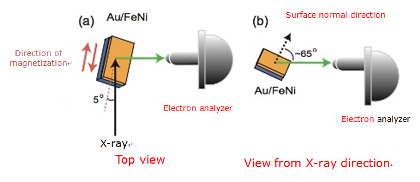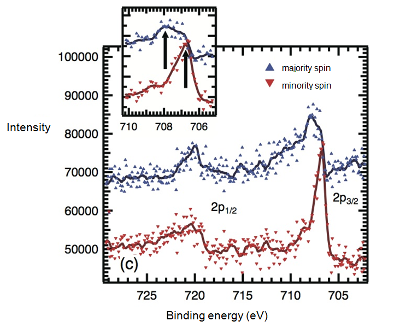Detection of Spin-Resolved Electronic States from a Buried Ferromagnetic Layer
The evaluation of spintronics devices and the engineering of new spintronics materials are expected.
2014.04.02
(2014.06.16 Update)
National Institute for Materials Science (NIMS)
Institute for Materials Research (IMR), Tohoku University
Research Institute of Electrical Communication (RIEC), Tohoku University
The joint research group led by Shigenori Ueda, NIMS senior researcher of Synchrotron X-ray Station at SPring-8, Masaki Mizuguchi, associate professor at IMR, Tohoku University, and Masafumi Shirai, professor at RIEC, Tohoku University, successfully detected spin-resolved electronic states from a buried ferromagnetic layer, which had been difficult to detect using conventional spin-resolved photoemission spectroscopy.
Abstract
- The joint research group led by Shigenori Ueda, NIMS (Sukekatsu Ushioda, executive president) senior researcher of Synchrotron X-ray Group, Quantum Beam Unit, Masaki Mizuguchi, associate professor at IMR, Tohoku University, and Masafumi Shirai, professor at RIEC, Tohoku University, successfully detected spin-resolved electronic states from a buried ferromagnetic layer, which had been difficult to detect using conventional spin-resolved photoemission spectroscopy.
- The direct observation of spin-resolved electronic states in a ferromagnetic layer that is buried in nonmagnetic material is critical for the development of devices such as hard disk heads that read data from magnetic recording media. However, it is difficult to obtain detailed information on buried ferromagnetic layers by using traditional spin-resolved photoemission spectroscopy, which is the method to measure the spin-resolved surface electronic states of materials.
- In order to measure the spin-resolved electronic states in a buried ferromagnetic layer, the research group used a high-brilliant hard X-ray generated by the third generation synchrotron radiation facility, SPring-8, since hard X-ray photoemission spectroscopy is known to be able to measure the electronic states from buried layers. In addition, the research group invented a new approach for electron spin detection method, which was combined with hard X-ray photoemission spectroscopy, greatly improving the detection efficiency. For example, the research group successfully detected the spin-resolved electronic states in a ferromagnetic layer made of FeNi (iron-nickel) alloy, which was buried under an Au (gold) thin film using this method.
- This new technique enables the direct observation of spin-resolved electronic states of ferromagnetic materials near the interface between the ferromagnetic and nonmagnetic layers. This technique will contribute to improvement in the performance of devices containing ferromagnetic materials and to the development of new spintronics materials through a comparison between the performance of spintronics devices and spin-resolved electronics states in ferromagnetic materials in the vicinity of the interface between the ferromagnetic and nonmagnetic layers.
- These results has been published in Applied Physics Letters, published by the American Institute of Physics.

Schematic diagrams showing the experimental geometry of newly developed spin-resolved photoemission spectroscopy in this work. (a) Top view. (b) View from X-ray direction. The use of a two-dimensional electron detector allows high-efficient spin-resolved measurements.

Spin-resolved Fe 2p core-level spectra of the FeNi alloy film buried under a Au capping layer. The spectral line shapes of the majority and minority spin spectra are different each other. The minority spin spectrum shows a shape peak, while the majority spin state shows a broad peak. The peak position of the minority spin state is lower than that of the majority spin spectrum. The inset shows the enlarged view of the region between 705 and 710 eV. The allows indicate the peakpositions for the majority and minority spin states. The energy difference between two peaks for the FeNi alloy film is about twice as that for the pure Fe. This result indicates that the magnetic moment of Fe in the FeNi alloy is larger than that of the pure Fe.
